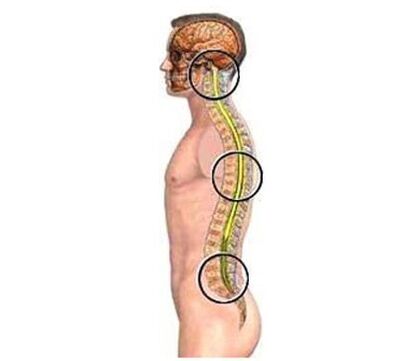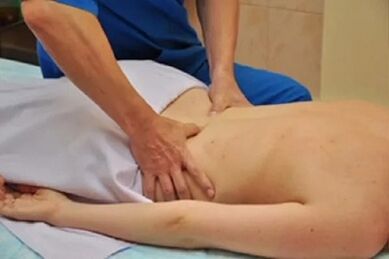Osteochondrosis is one of the most common, well-studied, but difficult to treat diseases of the musculoskeletal system. These are not just back pain and a lot of discomfort: over time and if left untreated, osteochondrosis can lead to the development of serious deformities and significantly reduce the patient's standard of living. It is therefore very serious to take this seemingly fearless disease even at the first signs.

Symptoms
Osteochondrosis very often goes undiagnosed for a long time. Osteochondrosis syndromes may not even point directly to the spine, disguising themselves as other diseases. And the patient "suppresses" the pain syndrome with painkillers, blaming everything for migraine - at best, and at worst - he is treated for a completely different disease, without seeing improvement for years.
In the initial stage of the disease, osteochondrosis manifests itself only with slight pain and discomfort after intense physical activity or long sitting in an awkward position on the table. The disease develops over the years, gradually all the symptoms worsen. Characteristics characteristic of osteochondrosis of the chest include:
- tingling and numbness in the limbs. Especially after a long stay in a position or sleep. This is one of the first signs of spinal problems. After rubbing, the tingling and discomfort pass quickly and do not cause severe discomfort;
- sensations of cold, itchy skin in the hands, often - on the hands or individual fingers, less often - in the affected area of the back;
- painful sensations often have a "wrong" localization. The pain can occur both in the area of the affected area of the spine and radiate (give off) in the area of the chest, resembling pain in heart disease, it can occur when breathing. Therefore, when osteochondrosis is diagnosed in the presence of pain in the heart area, an ECG will be a mandatory study - to rule out ischemic disease. Also, pain is often given in the scapular area (intercostal neuralgia) or the left arm;
- painful sensations often intensify at night;
- also the patient is often tormented by a migraine-like headache. They can appear on one side of the head or cover the whole head;
- general decrease in well-being, mood;
- thoracic osteochondrosis is rarely accompanied by spinal cord compression. But if this happens, the symptoms will be more pronounced: the pain becomes strong, accompanied by serious disorders of the internal organs.
All the symptoms of osteochondrosis are a consequence of the compression of the nerve roots passing along the spine. Depending on the area and degree of compression, the symptoms can vary greatly, so at the first suspicion of osteochondrosis it is very important to do instrumental tests and make the correct diagnosis.
Osteochondrosis of the chest area rarely occurs on its own - the chest area is inactive and less stressed, most often this disease is combined with cervical osteochondrosis.
Methods of treatment of osteochondrosis
Like all degenerative diseases of the musculoskeletal system, osteochondrosis is very difficult to treat for a long time - there is no simple and quick cure. You need to be prepared for this. It is impossible to reverse the degenerative changes in the intervertebral discs. The ideal option is to stop the development of the disease in the initial stage, when osteochondrosis does not impose any restrictions on the patient's lifestyle. In the earliest stages, it is enough to slightly adjust the patient's lifestyle: to increase physical activity, to make the diet complete. But it is extremely rare to diagnose at the very beginning of the development of pathological changes.
The traditional complex of therapy for osteochondrosis includes:
- Drug therapy. . . It consists of several components:
- with severe pain syndrome, the patient is prescribed painkillers. These are most often non-steroidal anti-inflammatory drugs (NSAIDs). Less commonly, steroidal anti-inflammatory drugs, opiates, and opioids are used. They are stronger, but have many limitations on their use;
- mandatory part of treatment is the intake of supplements and vitamins that strengthen the bone system;
- muscle relaxants help relieve muscle tension. But it must be said that without constant exercise in medical gymnastics, taking muscle relaxants is strictly contraindicated;
- The use of chondroprotectors helps to accelerate the recovery process in the affected area, although the attitude of specialists to such drugs is very unclear.
- Treatment without drugsis much more important for the successful treatment of osteochondrosis.
- first of all, one must concentrate on the systematic and correct implementation of the complex of therapeutic gymnastics. Exercise therapy is aimed at strengthening the muscular corset around the spine, accelerates local blood circulation and with regular exercise can significantly improve the patient's condition;
- Physiotherapy treatments help relieve muscle pain and tension. They act in the same way as anti-inflammatory painkillers, but have far fewer contraindications;
- mass therapy. Both the traditional therapeutic massage and many alternative methods are practiced, the main selection criterion is the professionalism of a specialist and consultation with the attending physician;
- manual therapy;
- traction (traction therapy) on a special simulator. The gentle grip of the spine allows you to relieve muscle tension and reduce the symptoms caused by compression of the nerve roots;
- you also need to change the approach to your diet, to make it more balanced.

Therapeutic exercises for osteochondrosis of the chest
You can do medical gymnastics both in a special room in the hospital and at home. The more frequent and regular the sessions, the higher the efficiency. It is recommended to hold classes several times a day, morning exercises are a mandatory part of the complex. Each workout should last from 5 (in the first stage) to 40 minutes, and the number of repetitions of each exercise should be from 5 to 20. Here is an example set of exercises:
- Lie on your back, the surface should be flat and hard, for convenience you can put a fitness mat. Bend your knees, then simultaneously stretch your knee toward your nose and your head toward your knee. Hold at the top point for a few seconds, return to the starting point, change legs;
- Universal exercise - familiar to all from childhood "cat". Get on all fours upside down. As you inhale, bend your back as much as possible and raise your head. Then, as you exhale, bend your back and lower your head;
- In the middle of the working day you can take a break for a simple exercise: successively raise each shoulder as high as possible, while one shoulder is raised, the other goes down;
- Sit in a chair with your back reaching to the shoulder blades (a regular office chair will do the job), press your back firmly against the back of the chair. Then raise your arms and bend your upper back as much as possible;
- Make several circular motions as wide as possible with your arms outstretched. Performed while sitting on a straight hard chair or standing;
- Stand with your feet shoulder-width apart. Clasp your hands behind your shoulders. Lean back as much as possible in the chest area, resisting with your hands;
- Also, from an upright position, hunched over as much as possible, the chin leans towards the chest, shoulders towards each other. Hold in the lowest position for a few seconds. Then make a movement on your back: straighten your shoulders as much as possible, gathering your shoulders and throwing your head back. The exercise is performed at a slow and smooth pace.
Osteochondrosis of the chest can develop very slowly without causing much concern for a long time, but as a result the patient faces many limitations of his usual lifestyle and the fact that the standard of living is constantly falling. Therefore, if you experience the first sensations of discomfort and mild pain, you should consult a doctor.






















